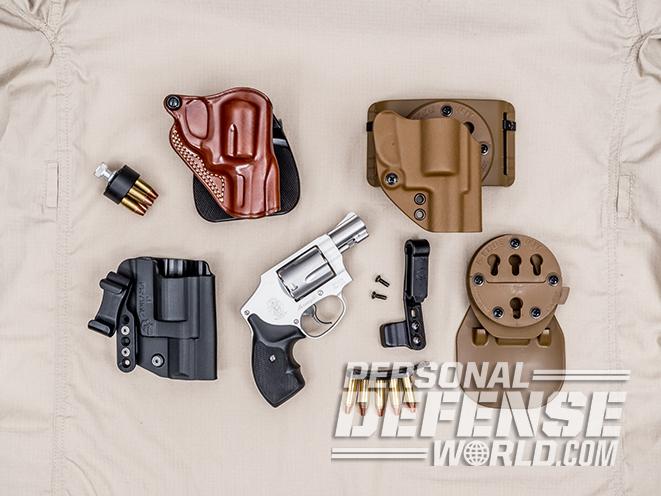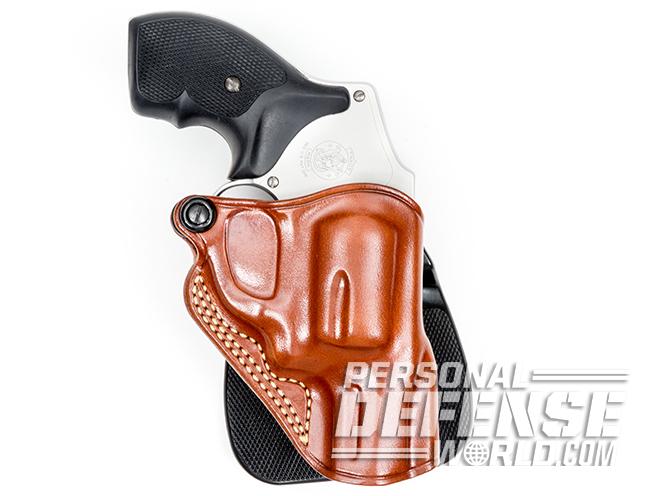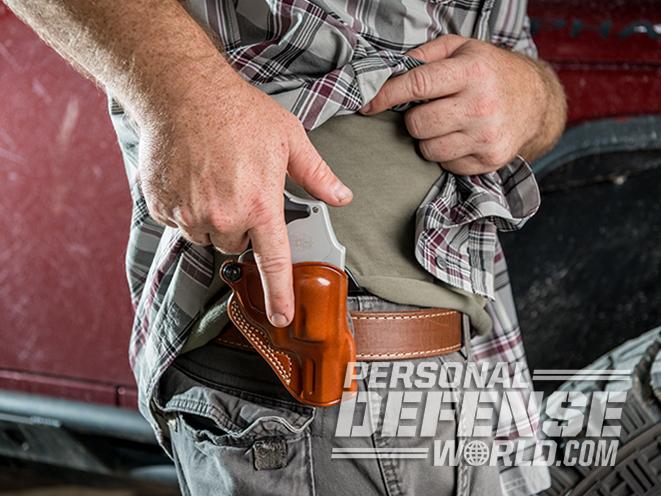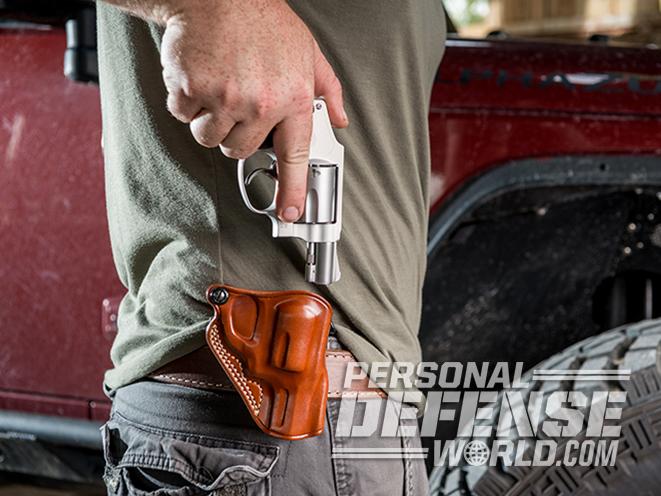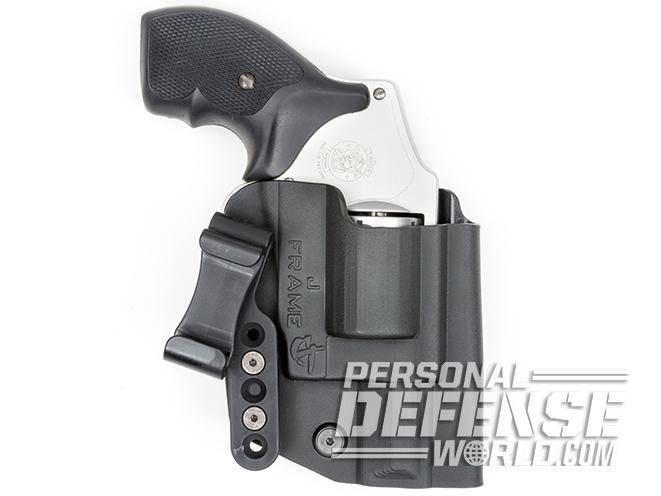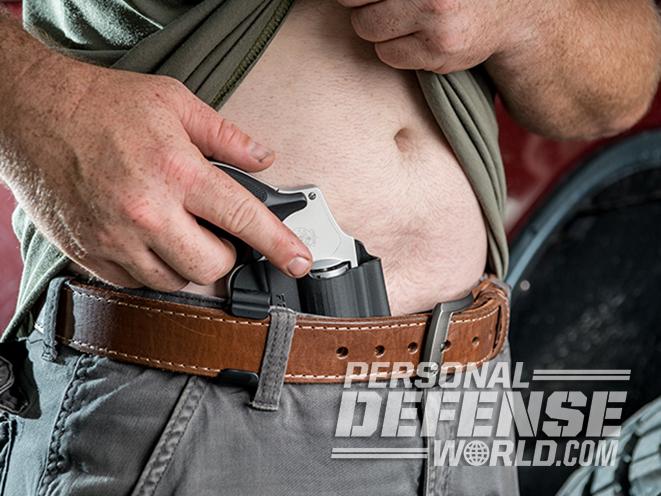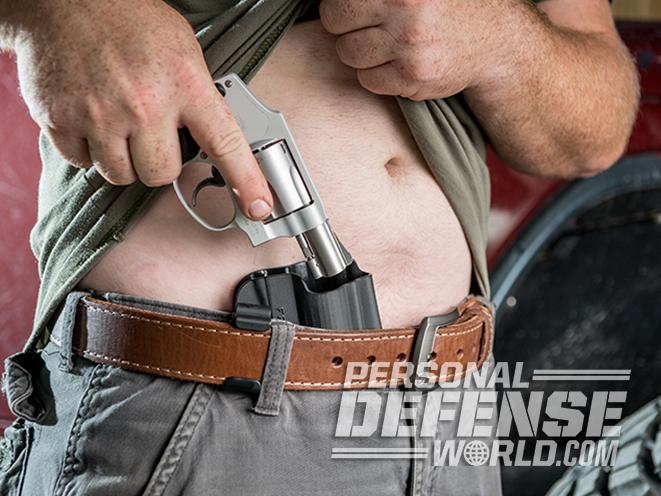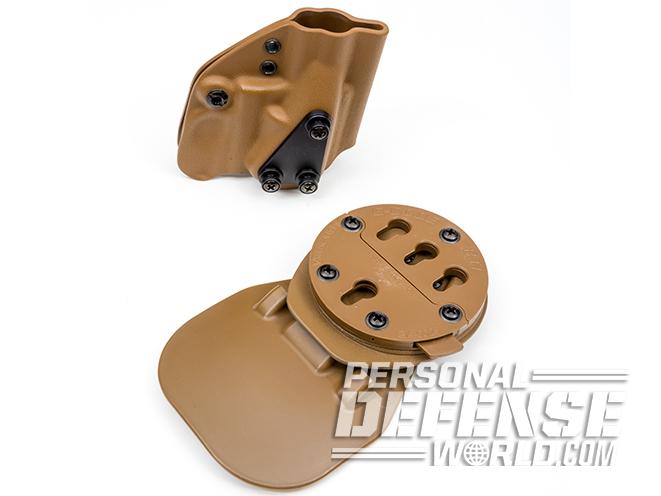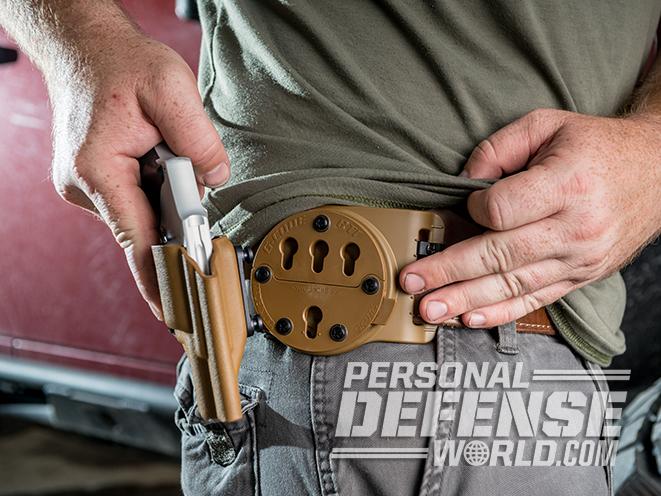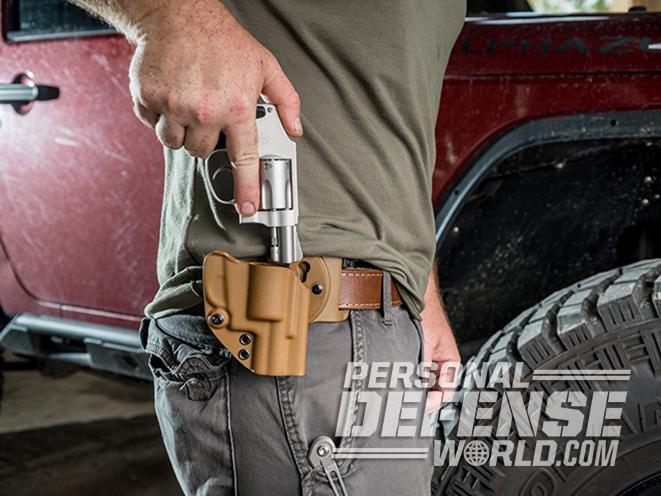Very few revolvers have been as successful as the Smith & Wesson Model 642. Introduced in 1995, the J-Frame revolver weighs less than a pound, has a five-shot capacity and stainless steel and alloy construction. Its internal hammer allows for a sleek, no-snag design, and its double-action-only (DAO) trigger makes this a true point-and-shoot gun.
The 642 can trace its lineage all the way back to 1950, when Smith & Wesson introduced the Chief’s Special. The little J-Frame developed by Smith & Wesson also launched the Bodyguard, a shrouded-hammer, five-shot revolver, capable of both single-action (SA) and DA fire, and the Centennial, a five-shot DAO. Even back in 1952, S&W offered a version with an alloy frame called the Model 42. Utilizing corrosion-resistant stainless steel for the cylinder, barrel and yoke, S&W updated the gun in 1995 and designated it as the Model 642 Airweight.
Model 642
I’ve always been a semi-auto guy and really had no interest in revolvers for carry, but so many of my cop friends swore by them. Some carried the gun as a backup in an ankle holster while others simply dropped the gun in one of their pockets. One cop told me, “In cold weather, most guys have one in their coat pocket, and it looks like they are trying to keep their hands warm when, in reality, they have their hand wrapped around their gun. If things go bad, we can shoot without even removing the gun from the pocket. There’s no external hammer to snag on the pocket lining.”
Advertisement — Continue Reading Below
Undercover guys found the little gun incredibly easy to use for deep concealment and loved that the alloy and stainless steel required very little maintenance. After hearing so many testimonials about the 642, I felt like I needed to add one to my collection about six years ago.
The Model 642 is +P rated, and there have never been so many good ammunition choices for self-defense use. Handicapped by the short 1.88-inch barrel, ammunition selection becomes especially critical here. It’s always a balancing act with lightweight guns to find a controllable load that still packs enough of a punch. So I collected five of what I thought were the most effective loads I had in my ammo cabinet from Black Hills, CorBon, DoubleTap, Hornady and Super Vel and went to the local range to chronograph them.
Super Vel is an old name that has been resurrected by former firearms editor and industry insider Cameron Hopkins. Using the original Super Vel formula of light projectiles at hyper velocities, the +P hollow-point rounds generated a whopping 319 foot-pounds of energy (fpe) from the 642’s stubby barrel. Just behind it was CorBon’s 110-grain +P round with its cavernous DPX hollow point and 314 fpe. Both loads were a handful to shoot but not unmanageable by any means. Firing from a standing, two-handed position with my target at 7 yards, my groups ranged from a little more than 0.5 inches to just slightly more than 1.5 inches.
Advertisement — Continue Reading Below
But you’re here for holster options, right? The Model 642’s diminutive size and light weight make it tempting to simply place the gun in the waistband of your pants or drop it in a pocket. And this never seems to be a problem until you need to get to your gun quickly. Having the right holster will keep the gun secure yet provide a stable platform for consistent draws. That’s why we’ve collected samples of holsters for the S&W Model 642 from Galco, Comp-Tac and G-Code for testing.
Galco Speed Paddle
I’m one of those people always battling the bulge with the need to lose five or 10 pounds. I buy my pants to fit and not a waist size bigger, so IWB carry, other than in the appendix position, can sometimes be uncomfortable, and that’s where paddle holsters shine. Galco sent a copy of its Speed Paddle Holster for evaluation.
Crafted from premium steerhide and double stitched, the Speed Paddle features adjustable retention and a forward cant. The holster’s paddle is made of injection-molded polymer that is contoured for the hip and is designed to be worn between the 3 and 4 o’clock positions. A belt lock anchor is also molded into the paddle to keep the holster in place when the weapon is drawn, yet the rig is easy to remove without taking off your whole belt.
Advertisement — Continue Reading Below
Galco’s design rides high on the hip, and the paddle holds the gun against the body for maximum concealability. It makes the Model 642 effortless to carry yet instantly available for presentation. Galco’s Super Paddle is available for most J-Frame guns and other manufacturers’ small-frame revolvers.
Comp-Tac 2 O’Clock IWB
While many people think of Comp-Tac as a manufacturer of competition holsters, the company also offers a full line of duty and concealed-carry rigs. We received a sample of Comp-Tac’s 2 O’Clock IWB holster for the Model 642.
This holster is designed to be worn in the appendix position and is constructed from rigid Kydex. Attached to the holster body is a flexible yet durable nylon belt clip that is adjustable for ride depth and works with 1.5-inch-wide belts. By tightening the two belt clip screws plus the screw on the muzzle end of the holster body, the retention can be adjusted.
Advertisement — Continue Reading Below
- RELATED STORY: 7 of Our Favorite Pocket Holsters for Concealed Carry
The belt clips have less surface area than most and have a non-reflective black finish, making them barely visible. When putting the holster on, the belt must be fed through the clip, which isn’t a big deal at all. Once the holster is positioned, button your pants, zip up and adjust your belt. The 2 O’Clock’s belt clip is designed so you can tuck your shirt between the holster body and the clip for maximum concealability.
Because of its rigid construction, it is easy to reholster the gun; the holster mouth won’t collapse. The low-friction holster material makes presentations extremely fast, and a satisfying pop is heard when the gun is withdrawn and holstered. I found the holster to be extremely comfortable and wore it without problem for hours while driving. Comp-Tac’s 2 O’Clock IWB is lightweight and requires virtually no maintenance, making it a perfect match for the Model 642.
G-Code RTI Kydex
G-Code sent me one of the most ingenious and versatile rigs I have ever seen. Called the Revolver RTI Kydex holster, this precision-molded product has the ability to be carried IWB or with a quick-detach paddle or belt slide.
Advertisement — Continue Reading Below
The heart of the G-Code system is its Rapid Transition Interface (RTI) mounting adapter which securely holds the holster until the user decides to detach it. The adapter can also be adjusted for angle or cant. Both a belt slide—accommodating 1.5- to 2-inch-wide belts—and a paddle serve as the mount to quickly and easily attach the holster via the RTI hangers or bolt heads, which look very much like an AR-15’s KeyMod system. Once the hangers are inserted into the teardrop-shaped holes, the user can activate the locking lever for a tremendously secure and rigid platform.
Need to stop at the bank and make a deposit? Drop your kid’s lunch off at school? Stop by the watering hole to have a drink with a colleague? Simply unlock the RTI and remove the holster and gun. It’s quick and easy and doesn’t involve unthreading your belt or dropping your pants to remove the paddle.
I also received an IWB nylon belt clip for the holster, and it attaches easily with two screws. It isn’t adjustable for ride height, but it is tuckable. The hangers on the other side of the holster will need to be removed so they don’t dig into your skin when used with the IWB belt clip.
Advertisement — Continue Reading Below
While I have highlighted products from each of these companies, they all offer other holsters designed for S&W Model 642 revolvers. Take a look at their websites and decide which products suit your concealed-carry needs the best. Be armed, be aware and be responsible.
For More Information
Comp-Tac
comp-tac.com
Galco
galcogunleather.com
Advertisement — Continue Reading Below
G-Code
tacticalholsters.com
This article is from the November/December 2017 issue of “Combat Handguns” magazine. To order a copy and subscribe, visit outdoorgroupstore.com.
